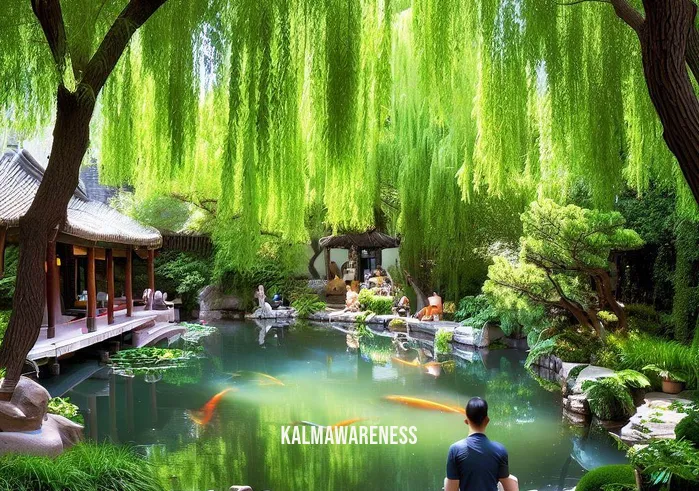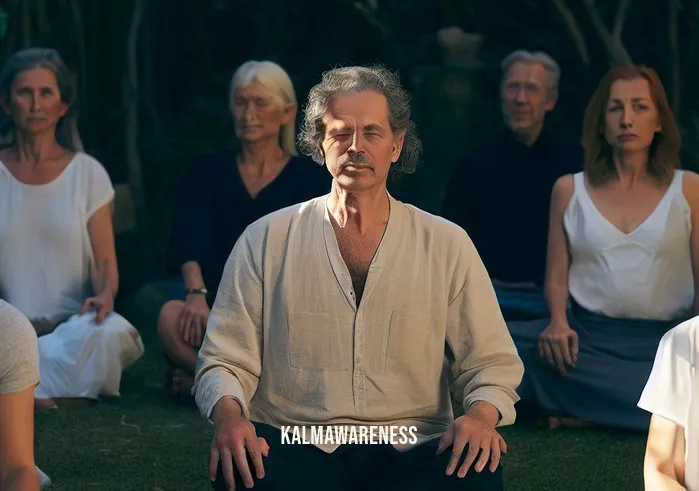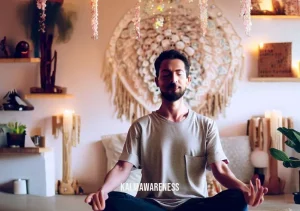The Multifaceted World of Chinese Meditations: A Journey Towards Inner Peace
Introduction to Chinese Meditations
The intricate world of Chinese meditations offers an array of techniques aimed at achieving inner harmony, better mindfulness, and a deeper understanding of the self and the universe. These practices, rooted in philosophies like Zen, Taoism, and Qi Gong, promote a more balanced life, mental clarity, and emotional stability. Before you dismiss meditation as an abstract concept or something that isn’t practical for daily life, it’s crucial to understand the different aspects of Chinese meditations and how they can be readily integrated into your daily routine.
The Philosophical Foundations: Zen, Taoism, Qi Gong
Chinese meditations are firmly grounded in three major philosophical systems: Zen Buddhism, Taoism, and Qi Gong. Zen emphasizes the experience of enlightenment and promotes mindfulness through meditation practices. Taoism focuses on living in harmony with the Tao, the fundamental nature of the universe, often incorporating breathing and movement techniques. Qi Gong, meanwhile, is a system that combines movement, breathing, and meditation to cultivate and balance “Qi,” the life force energy.
“Meditation involves attaining a peaceful state of mind in which thoughts are not occupied by worry.”
This wisdom holds true across the broad spectrum of Chinese meditations. Whether you are a seasoned meditator or a beginner, there is a practice tailored to your needs and lifestyle. For those who are new to this world, experts like Jack Kornfield offer a variety of approaches to meditation for beginners.
How Does Chinese Meditation Affect Your Mind and Body?
Chinese meditations are not solely spiritual exercises; they also offer various psychological and physiological benefits. Techniques can range from focusing on your breathing, an element of some meditation exercises, to walking meditations, ideal for teenagers walking to school or adults taking a lunch break. The physical benefits include improved sleep, for which mindful movement sleep exercises can be particularly effective, and even practices like mindful hypnobirthing have garnered attention for their ability to ease the challenges of childbirth.
The Versatility of Chinese Meditation Practices
You might wonder, “Can you meditate lying down?” or “Do I need a specific posture for it?” The good news is that these practices are incredibly flexible. Whether it’s a seated meditation, lying down, or even incorporating it into a sustainable self-care routine, the options are limitless. Such versatility makes it easier to stabilize your emotional well-being, a feat easier said than done.
The Importance of Breathing
Breathing is not merely a biological function but a crucial aspect of Chinese meditations. Proper breathing techniques can help you touch that body part of your mind responsible for emotional regulation and stress management. Mindful breathing plays a pivotal role in these practices and can be your first step towards a harmonious life.
Why Keep Practicing?
Just as a plant requires consistent care and attention, so does your practice of meditation. Keep in mind that the journey toward inner peace is a long-term commitment, not a one-time event. To sustain your practice, you can use various methods like gratitude meditation before sleep, or even adopt specific activities, one for each blessed day, to ensure that you keep progressing.
What’s Next?
Intrigued by the power and flexibility of Chinese meditations? In the next segment, we’ll delve deeper into the different types of practices, explaining each one’s unique benefits and how to incorporate them into your daily life. From understanding the judgment of the wise to exploring how to train your mind to be stronger than your feelings, we will guide you through the labyrinth of choices.
Do you want to know how we get so deep, so fast into the meditative state? Are you curious about mirror gazing spiritual benefits or interested in adopting a routine involving rouse yoga to further enhance your meditation experience? Continue reading to find out more.

The Spectrum of Practices: Unlocking the Power of Chinese Meditations
The Many Forms of Chinese Meditations
As we delve deeper into the domain of Chinese meditations, it becomes apparent that this ancient practice offers a plethora of options tailored for different needs and lifestyles. The richness and variety in methods are what make these Eastern practices not only timeless but also universally applicable. From the philosophically profound Taoist methods to the practical routines in Qi Gong, each form aims to help you keep in mind the broader definition of well-being.
Varieties and Techniques: A Brief Table Overview
| Type of Meditation | Core Principles | Suitable For |
|---|---|---|
| Zen Meditation | Mindfulness, Simplicity | Stress relief, spiritual growth |
| Taoist Meditation | Harmony with nature, Balance | Emotional well-being, deep relaxation |
| Qi Gong | Movement, Breathing | Physical wellness, energy balance |
| Mindful Movement | Awareness through movement | Improved sleep, physical flexibility |
| Rouse Yoga | Dynamic stretches and postures | Physical strength, enhanced concentration |
Exploring the Zen Way
In Zen, it’s often said that the “judgment of the wise” emerges when the mind is freed from the clutches of overthinking. Zen teaches that enlightenment is not a far-off goal but a present moment reality, attainable through consistent practice.
Taoism: The Way of Harmony
Taoism is often encapsulated in the idea that life should be lived in harmony with the Tao, which translates to “the Way.” To facilitate this, various Taoist meditation methods help you to stabilize your mind and feelings.
Qi Gong: The Art of Breathing and Movement
Qi Gong is a practice that involves dynamic movements combined with controlled breathing. It’s not merely an exercise but a form of moving meditation. You can even incorporate Qi Gong into sustainable self-care practices to amplify your wellness regimen.
Advantages and Practical Applications
One might wonder, why are these meditative practices so effective? The secret lies in their ability to help train your mind to be stronger than your feelings. They don’t just offer temporary respite but bring about a transformation that becomes ingrained in your daily living.
Bullet Point Summary:
- Physical Benefits: Improved sleep quality, increased energy levels, and enhanced immune system.
- Psychological Advantages: Reduced stress, better emotional regulation, and increased happiness.
- Spiritual Rewards: Greater sense of connection to the world, heightened self-awareness, and spiritual growth.
- Universal Usability: Techniques such as mirror-gazing offer spiritual benefits that are not confined to any single belief system.
- Long-term Impact: Consistent practice leads to sustainable self-care and long-term benefits.
Curious to Dive Even Deeper?
If you’ve been intrigued by the myriad forms and significant benefits of Chinese meditations, you’re in for a treat as we continue our exploration. How is it that we get deep so fast into a meditative state? What are the foundational theories behind such rapid yet profound changes? And are there specific practices aimed at cultivating gratitude or preparing the mind for sleep?
These are just a few of the questions we’ll tackle in the next chapter. We’ll also delve into how to enrich your meditation practices with techniques that focus on elements like gratitude and sleep. Continue reading to unfold the ancient wisdom encapsulated in Chinese meditations, as we demystify these Eastern practices for modern-day use.

The Light Within: Finding Hope and Inspiration Through Chinese Meditations
The Nourishing Essence of Hope in Chinese Meditative Practices
Chinese meditations extend far beyond mere relaxation or stress relief. At its core, this tapestry of ancient techniques is designed to cultivate inner light, hope, and profound inspiration. The practices rooted in Zen, Taoism, and Qi Gong have been fueling this hopeful transformation for centuries. It’s time to explore how meditation made simple can be a vessel for nourishing the soul and uplifting the spirit.
Quotable Wisdom: Seeds of Hope
“Do not dwell in the past, do not dream of the future, concentrate the mind on the present moment.” – Buddha
This quote resonates deeply with the Zen concept of mindfulness, reminding us to stay rooted in the now as a way to cultivate inner peace and hope.
“Be content with what you have; rejoice in the way things are. When you realize there is nothing lacking, the whole world belongs to you.” – Lao Tzu
Taoist meditation often leans on the wisdom of Lao Tzu to encourage contentment as a path to enlightenment and inner joy.
“Energy flows where attention goes.” – Traditional Qi Gong saying
Qi Gong teaches us to redirect our energies as a means of self-healing and revitalization, making it a practice infused with potential for transformation and hope.
How Chinese Meditations Inspire Mindfulness and Emotional Strength
It’s often said that to be truly inspired, you need to be in touch with your inner self. In the realm of Chinese meditations, mindfulness is not just a fleeting concept but a living experience. When you train your mind to be stronger than your feelings, you’ll find that the path to inspiration is a natural progression. Whether it’s the calming influence of gratitude meditation before sleep or the psychological lift provided by one for each blessed day, these practices are effective avenues to find what inspires you.
Chinese Meditations and the Universal Experience of Inspiration
The beauty of Chinese meditations lies in its universal appeal. You don’t need to be an expert or even have prior experience. Even teenagers walking can incorporate mindfulness into their routine. This inclusivity means that hope and inspiration are accessible to everyone, regardless of age or background. When you adopt these practices, you’re opening the door to a lifelong relationship with peace and inspiration.
Bridging the Gap to Your Inspired Self
Chinese meditative practices are more than just an ancient ritual; they are a living testament to the human capacity for change and growth. It’s not just about adopting a new habit but about transforming your life in a way that brings daily inspiration.
Key Areas of Inspiration:
- Personal Growth: Develop emotional intelligence, resilience, and a stronger sense of self.
- Spiritual Enlightenment: Experience a deeper connection to a greater cosmic energy.
- Emotional Balance: Find joy, peace, and emotional stability even in challenging times.
- Global Connection: Understand that your well-being contributes to the collective well-being of humanity.
What’s on the Horizon?
If you’ve come this far, your curiosity and openness toward Chinese meditations are likely piqued. You may be wondering how to sustain these practices long-term or how they can specifically enhance your emotional and physical well-being.
In the next chapter, we will focus on making Chinese meditations a lasting part of your life. We’ll explore how these practices can be the cornerstone of sustainable self-care, touching on aspects like mindful movement for improved sleep, hypnobirthing techniques, and other forms that can help you attain a peaceful state of mind free from worry.
There’s so much more to discover in this rich tradition. Continue reading to deepen your understanding and elevate your practice.

Unveiling Layers: An In-depth Exploration of Chinese Meditations
The Many Facets of Chinese Meditations: More Than Meets the Eye
Chinese meditations are not a monolith; they are a rich, intricate tapestry with multi-layered elements. From Zen to Taoism, Qi Gong to Mindfulness, each has a unique philosophy and set of practices. For those wondering how to spell stabilize their mental and emotional well-being, these practices offer an in-depth pathway to internal equilibrium.
Key Components Often Overlooked
Intention Setting: This is an essential yet often ignored component. Meditation doesn’t only involve attaining a peaceful state of mind in which thoughts are not occupied by worry; it begins with setting the right intention.
Incorporation of Movement: The notion that you can’t meditate lying down is a myth. Qi Gong, for example, involves mindful movement, showing that stillness and activity are two sides of the same coin.
Body Awareness: This isn’t just about your mind. Practices often touch that body part which needs healing, making the meditation a more holistic experience.
The Wisdom of Inclusion: Judgement of the Wise
Not all forms of Chinese meditation are created equal, nor do they aim for the same goals. This is what makes the practice a judgment of the wise — knowing which form or combination of forms is best suited to an individual’s unique needs.
Breaking Down Myths and Misconceptions
Myth 1: Chinese meditations are only for religious or spiritual people.
- Fact: These practices are for everyone and serve multiple purposes, including stress relief and improved physical health.
Myth 2: You need to meditate for hours to see benefits.
- Fact: Even short sessions can bring about significant changes. It’s about quality, not just quantity.
Myth 3: Meditation is about emptying the mind.
- Fact: It’s more about focused attention and awareness. Some meditation exercises involve focusing on specific elements like breath, mantra, or even an object.
List of Chinese Meditations and Their Primary Benefits
| Type of Meditation | Main Benefit | Suitable For |
|---|---|---|
| Zen | Mindfulness | Beginners |
| Taoist | Balance | Intermediate |
| Qi Gong | Vitality | All levels |
| Mindfulness | Awareness | Beginners |
| Harmony-focused | Peace | All levels |
What’s Next? The Final Frontier
If you’ve made it this far, you’ve already begun to pierce the surface of the multifaceted world of Chinese meditations. But what about making these practices a part of your everyday life? How can we get deep so fast into a state of being that nourishes our spirit day in and day out?
In the final chapter, we’ll wrap everything up by examining how to integrate Chinese meditations into your daily routine for sustained benefits. We’ll also touch upon more nuanced forms like mirror gazing for spiritual benefits and even delve into the practice of Rouse Yoga, which merges ancient Chinese principles with modern-day mindfulness.
Your journey through the world of Chinese meditations is about to come full circle. Continue reading to grasp the ultimate insights and to make this enriching practice a part of your life.

The Journey Within: Reflecting on Chinese Meditations
A Soothing Voyage to Inner Harmony
As we wrap up this enlightening exploration of Chinese meditations, it’s important to reflect on the transformative journey we’ve taken together. The practice of meditating, deeply ingrained in Zen, Taoism, Qi Gong, and Mindfulness, is not just a temporary escape but a life-altering expedition into your inner cosmos. You may have had fleeting moments where you felt the need for mindful hypnobirthing or even wondered, “Can you meditate lying down?” The diversity of this ancient art ensures there’s something for everyone.
The Gift That Keeps on Giving
Before we say goodbye, let’s remember the One for Each Blessed Day approach. Whether it’s practicing gratitude meditation for better sleep or adopting sustainable self-care methods, the essence lies in daily practice.
“Train your mind to be stronger than your feelings, and you’ll find each day brimming with potential.”
The Awe-Inspiring Benefits: Why You Should Continue
You’ve seen the multitude of benefits, from stress relief to spiritual growth. Now it’s time to keep those practices going! Why stop when you’ve just started unlocking the treasure trove of benefits? From improving your ability to focus, to enhancing your emotional balance, Chinese meditations are the gift that keeps giving.
Heartfelt Thanks and Future Explorations
I’d like to take this opportunity to thank you for joining me on this incredible journey through the ancient art and modern utility of Chinese meditations.
“May you live every day of your life.” – Jonathan Swift
Your exploration shouldn’t stop here. I encourage you to revisit previous sections for deeper clarity or dive into other related content. As we say in the world of mindfulness, the journey is the destination.
Let the Adventure Continue
Your exploration into the world of Chinese meditations doesn’t have to end here. Whether you’re a curious teenager who enjoys walking and exploring or you’ve been practicing mindfulness for years, the wealth of information and techniques in our magazine offers a plethora of avenues for further exploration.
A Journey Worth Revisiting
Remember, each journey begins with a single step, and your step into the world of Chinese meditations can lead you to a lifetime of wisdom and serenity. Keep this in mind as you move forward: the journey is as important as the destination.
“The journey of a thousand miles begins with one step.” – Lao Tzu
A Call to Action: Don’t Stop Now!
If this series has kindled your interest, don’t stop now. We have many more exciting articles and resources that can help you deepen your practice and understanding. Feel free to explore more content in our magazine and enrich your life with the wisdom of these ancient practices.
Closing Remarks: See You Soon!
Once again, thank you for dedicating your time to this meaningful exploration. As Jack Kornfield wisely puts it, meditation for beginners or experts is about finding your own path. Rest assured, there will be more insightful content in future editions to help you on your spiritual quest.
May this be the beginning of a lifelong journey into the sublime world of Chinese meditations. Until next time, be well, be mindful, and be you.




